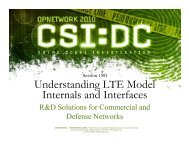Automated Axon Tracking of 3D Confocal Laser Scanning ...
Automated Axon Tracking of 3D Confocal Laser Scanning ...
Automated Axon Tracking of 3D Confocal Laser Scanning ...
You also want an ePaper? Increase the reach of your titles
YUMPU automatically turns print PDFs into web optimized ePapers that Google loves.
emission filter (Kasthuri et al., 2003). The images were sampled at the Nyquist limit in theimaging plane (pixel size = 0.1 micron) and over-sampled by a factor <strong>of</strong> 1.5 in the directionnormal to the imaging plane (optical section thickness = 0.2 micron), and with a 12 bit dynamicrange. Since the axons are not stained, the background is minimal in the acquired images. Thegoal <strong>of</strong> the developed algorithm is to build a three-dimensional model <strong>of</strong> the centerlines <strong>of</strong> theaxons present in the dataset.MethodsThe dataset available for analysis is a sequence <strong>of</strong> cross-sectional fluorescent microscopicimages <strong>of</strong> axons. These images can be stacked together to get a better picture <strong>of</strong> the axonspresent in the dataset. MIP-based tracking algorithms (Can et al., 1999; Zhang et al., 2006) workonly when the axons are well separated, which is <strong>of</strong>ten not the case. Thus, axon cross-over is<strong>of</strong>ten encountered when tracking them in two dimensions. Since they never intersect in threedimensions, we resort to a different approach in such special cases. The following flow chartshows the workflow <strong>of</strong> the algorithm:7















